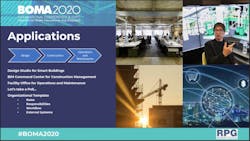Session Explores Bridge Between Physical and Virtual Workplace (BOMA 2020)
A new type of workspace model that fuses the virtual and physical environments could help improve communication and collaboration between on-site and remote workers, according to Mark Kadonoff, owner/CEO of RPG Squarefoot Solutions.
Kadonoff delivered a forward-thinking presentation titled “Hybrid Virtual/Physical Workspaces for Enterprise Collaboration” at the 2020 BOMA International Conference & Expo Tuesday.
Essentially, the model is what Kadonoff referred to as a “digital twin” of the physical building, constructed from BIM models, Internet ofThings (IoT) sensor data and information from the field. What’s interesting about this model-centric concept is that it isn’t simply focused on buildings; it also takes people into account, complete with avatars that correspond to users interacting in the physical environment. It allows for interoperability between humans and software, which Kadonoff defined as “the ability of different information systems, devices and applications to access, exchange, integrate and cooperatively use data in a coordinated manner.”
Kadonoff noted that this virtual-physical hybrid is critical for design, construction and operations because it allows people to:
- Design organization for interoperability;
- Organize teams virtually and physically;
- Define workflows;
- Organize content; and
- Define systems of record.
Utilizing IoT , including hardware (sensors and controllers), software, Internet and cloud applications, the model is ideal for managing everything from environmental systems to energy management, security and safety to tenant wellness, Kadonoff said.
Although somewhat challenging to visualize, the concept works like this: Virtual, parametric models with a predetermined number of sides, wall lengths and heights (a hexagon for example) are created in BIM as a series of interconnected “workgroup pods,” in which team members are visible as avatars driven by position sensors. The physical workspace then mirrors the virtual workspace based on the geometric model, complete with AR/VR and video walls that display shared information across teams.
Using the example of a design studio to create smart buildings, Kadonoff demonstrated how a project team could work seamlessly through conceptual design, schematic design and construction documents, with these content/team pods moving between levels of the organization and sharing information.
The question on attendees’ minds seemed to be: Why take this sort of hybrid spatial approach? Kadonoff answered by suggesting that a physical/virtual workspace:
- Is an innovation platform that transforms communications through visualization;
- Creates a conceptual framework for managing data;
- Provides a workspace that can be used physically or remotely;
- Defines a tool that can be used for communication analysis within an organization; and
- Establishes a framework for smart organizations and smart buildings.
The proof of concept is yet to be seen, but with organizations rethinking their work structures and physical workspaces in light of the pandemic, attendees were given a glimpse into a possible solution for the future workplace.
Read Next: How Will We Replace the Baby Boomer FMs Set to Retire? (BOMA 2020)

